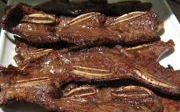Kalbi (Korean Short Ribs)
Pictured above: the version without bones.
Pictured below: the version with bones.
There are certain foods or food combinations that give me a food high. Really good pasta with a glass of red wine. Fresh Chesapeake crabs with drawn butter. Kalbi with rice and kimchi. Kalbi is one of my favorite things in the whole entire world.
Kalbi is a Korean dish. It is made with beef ribs that are cut thin, marinated in soy sauce, rice wine vinegar, brown sugar, garlic, ginger, etc. and grilled over a hot fire. In addition to providing amazing flavor, the brown sugar contributes to great caramelization on the meat.
Don’t ignore my recommended side dish: kimchi. Kimchi is fermented cabbage (or daikon radish or cucumber) seasoned with garlic, salt, chile peppers, and other secret spices. Cucumber kimchi is my favorite. Don’t skip the kimchi. The sweet, savory beef needs the tangy, spicy kimchi. Your mouth will thank you for it. Your breath, on the other hand…
A few thoughts before we get started:
- Use fresh garlic, fresh ginger, fresh (green) onions in the marinade. Don’t even think about using dry or powdered spices.
- Don’t skip the chopped pear in the marinade. An Asian pear is best. If you can’t find one, use a couple of regular, ripe pears. In a pinch, you can use 100% pear juice. Make sure it isn’t pear-flavored juice.
- Do not use traditionally cut beef ribs. These aren’t a BBQ-style rack of short ribs. You want thinly sliced, flanken-style ribs which are cut across the bone. Cutting across the bone makes each bone into a little cross-sectional disk (see photo above). The best place to find ribs cut this way is at a Korean market. If you don’t have one of those handy, ask your friendly neighborhood butcher.
- If you can’t find flanken-style beef ribs, buy boneless ribs (Costco has them). But before you marinate them, you need to make them really thin. Slice the meat into pieces that are 3 inches long and 1/2 inch thick. Then use a meat mallet to flatten them out. This not only tenderizes the meat, it gives it more surface area to absorb the marinade and makes it quicker to cook.
- The best way to cook this is over a hot charcoal grill. Second best is over a hot gas grill. Don’t cook this in a pan unless it’s a grill pan. You don’t want to boil the meat in the marinade. You want the meat to get a nice bit of char from the dry grill heat.
- Kimchi is a pain in the butt to make. Unless you’re a Korean grandma with a lot of time on your hands, you do not want to delve into kimchi making. You can find it in a Korean market. Many grocery stores carry it, too. My local Vons has it next to the tofu, soy cheese, etc.
- Beverage of choice with this: any Korean beer. If you can’t find any, go for some Red Stripe. If you’re under the legal drinking age, skip this bullet entirely.
INGREDIENTS:
- 1 cup brown sugar
- 5 cloves chopped garlic
- 1 tablespoon chopped fresh ginger
- 1 Asian pear, peeled and chopped
- 5 green onions, chopped (white and green parts)
- 1/2 cup mirin (rice wine vinegar)
- 3/4 cup soy sauce
- 1/4 cup water
- 1 tablespoon toasted sesame oil
- Black pepper
- 4 lbs beef short ribs
- Put all the ingredients, except the meat, in a large bowl and stir until sugar is dissolved
- Add the meat and move it around to coat it in the marinade
- Cover and refrigerate for at least 3 hours or overnight
- Alternatively: you can marinate the meat in 1 or 2 big zip-lok bags
- When you’re ready to grill, remove the ribs from the marinade
- Grill over a high heat, turning once
- If you want to make it look pretty, sprinkle some toasted sesame seeds and/or freshly chopped green onions on top before serving
- Serve with steamed rice and kimchi





